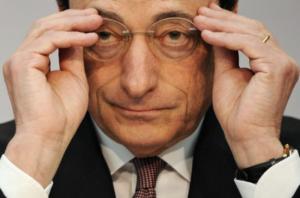It will take more than higher prices to cure what ails the European economy, but Wall Street reacted to the European Central Bank’s inflation-boosting efforts by setting new records yesterday.
Action by the ECB has been widely anticipated since last month, when ECB President Mario Draghi announced that the ECB would be “comfortable acting” at this month’s meeting. With a report this week that Eurozone inflation was just 0.5%, action by the ECB was all but certain. The ECB’s target rate of inflation is just under 2%.
Anticipation of ECB action has been helping to prop up the U.S. market at a time when the Federal Reserve Board is winding down its quantitative easing program by reducing its purchase of bonds by $10 billion per month. Apparently, as long as someone is following easy money policies, the markets are happy.
The actions announced by ECB President Mario Draghi did not include bond buying (although there are no Eurozone bonds). That’s in keeping with previous actions by Draghi, who previously relied on “forward guidance” to boost European markets and achieve monetary goals.
Forward guidance, as we’ve previously explained, is simply the act of talking about what the central bank will do in the future. Keeping interest rates low, for example, by saying that the ECB will keep interest rates low.
Banks to Pay for Deposits
The most significant action announced by the ECB was to lower the interest rate on bank deposits, including reserve holdings in excess of the minimum reserve requirements, from zero to -0.10%.
In other words, banks will pay a fee on money they fail to lend out. Whether or not that stimulates the economy, it could encourage banks to take more risk, approving loans that otherwise may not have been approved. Isn’t that what caused the financial crisis?
Other interest rates were also reduced. The rate on the Eurosystem’s main refinancing operations dropped 10 basis points to 0.15% and the rate on the marginal lending facility dropped by 35 basis points to 0.40%.
The ECB will also encourage lending by giving banks greater access to cash through “a series of targeted longer-term refinancing operations (TLTROs).”
Draghi also said, “if required, we will act swiftly with further monetary policy easing.”
Now that’s forward guidance.
From WIN to SIN
You may recall that the Fed has also been trying to increase inflation, which is a huge shift from the days when the Fed’s greatest task was to reduce and control inflation.
Back during the Ford Administration, Americans wore “WIN” buttons, because we wanted to “Whip Inflation Now.” In more recent years, one of the Federal Reserve Board’s rationalizations for continuing its quantitative easing program was that it wanted to push inflation up to 2%.
The U.S. annual inflation rate has finally met the goal of 2.0% for the period ended in April, so President Obama won’t need to consider a “SIN” campaign, for “Start Inflation Now.” The next inflation update is scheduled to be released on June 17.
So now that inflation has met the Fed’s inflation rate goal, why is the economy growing at a negative rate?

